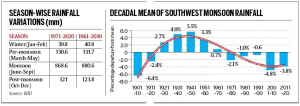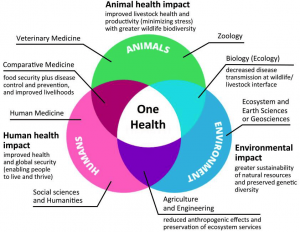THE GEOGRAPHY AND ENVIRONMENT
1. EXPLAINED: WHAT DOWNGRADE IN AVERAGE MONSOON RAINFALL MEANS?
THE CONTEXT: In its first-stage long-range forecast for the 2022 southwest monsoon, the India Meteorological Department (IMD) has forecast normal rainfall during the season. It has, however, downgraded the Long Period Average (LPA) for all-India monsoon rainfall — from 88.06 cm cm to 87 cm, effective from June this year.
THE EXPLANATION:
How much rainfall does India receive on average in a year?
Based on trends for 1961-2010, India’s normal annual rainfall is about 1176.9 mm. Of this, nearly 74.8%, or 880.6 mm (88.06 cm), occurs during the Southwest monsoon from June to September. This is the LPA rainfall for the monsoon, the figure that has been revised.
Before the revision, the distribution of the rest of the rainfall was 3.4% during winter (January-February); 11.2% in the pre-monsoon season (March-May), and 10.5% during the post-monsoon season (October-December).
How much rainfall does India receive on average in a year?
- Based on trends for 1961-2010, India’s normal annual rainfall is about 1176.9 mm. Of this, nearly 74.8%, or 880.6 mm (88.06 cm), occurs during the Southwest monsoon from June to September.
- This is the LPA rainfall for the monsoon, the figure that has been revised. Before the revision, the distribution of the rest of the rainfall was 3.4% during winter (January-February); 11.2% in the pre-monsoon season (March-May), and 10.5% during the post-monsoon season (October-December).

When is the LPA revised?
- It is an international convention to verify the quantum of annual and seasonal monsoon rainfall once in a decade. The monsoon season’s LPA rainfall acts as a baseline figure calculated over a 50-year period. The LPA is revised, if required, depending on any variations observed from the rainfall data obtained from the network of rain gauges.
- In 2002, the IMD operated 1,963 rain gauges located across 523 districts. As of 2020, rainfall data was being collected from 4,132 rain gauges spread uniformly across 703 districts.
- Between 2005 and 2010, India’s LPA was taken at 89.04 cm. Between 2011 and 2015, the IMD revised it to 88.75 cm. It was 88.06 cm between 2018 and 2021. From the upcoming monsoon the revised LPA will be 87 cm.
Why has it been downgraded?
- “According to the IMD forecast, the monsoon season rainfall shows an epochal behaviour, wherein the monsoon can shift between dry and wet epochs (30-to-50-year periods) in certain decades. The reduction in the rainfall is thus due to the natural multi-decadal rainfall variability”.
- The decadal variability between 1901 and 2020 shows the southwest monsoon rainfall underwent a dry epoch between 1901 and 1921. This was followed by a wet epoch that prevailed till 1970. From 1971, the monsoon has been passing through a dry epoch that persists till date.
- “Also, it highlighted, the dry epoch started in 1971 and has continued for five decades; thus the decadal mean rainfall values have remained negative. The decadal all-India southwest monsoon rainfall has been thus reducing by 1 cm. For 2011-2020, this value is minus 3.8, below normal”.
- But the peak of this dry epoch has been surpassed with the monsoon set to revive, report noted. “The future trend suggests that the decadal mean value will reach near normal during 2021-2030. It will then turn positive, meaning that the decade 2031-2040 will be the beginning of a wet epoch”.
- The decadal mean value for the ongoing decade is predicted to be around minus 1.4 to 1.5. Normally, the realised monsoon rainfall remains below normal for most years in a decade during a dry epoch. On the other hand, rainfall is normal or above normal during most of the years in a decade when it is a wet epoch.
So, has the all-India quantitative rainfall reduced?
- There is indeed a decrease in normal monsoon rainfall between 1961-2010 (880.6 mm) and 1971-2020 (868.6 mm). The all-India annual rainfall, too, has decreased from 1176.9 mm (based on 1961-2010) to 1160.1mm (based on 1971-2020).
According to the IMD officials, the shifting of rainfall, the otherwise dry and arid west-central India regions covering Kutch-Saurashtra, Rajasthan and parts of west Madhya Pradesh are reporting a higher number of wet days than normal. These areas had more rainfall during 1971-2020 than during 1961-2010.
“There is a positive change in western India regions with research showing an increase in days with light to moderate intensity rainfall increasing over Rajasthan,” However, on an all-India basis, rainfall reduction in some areas and increase in other areas do not contribute in a large difference in the total quantum.
2. NEPTUNE’S SUMMER TEMPERATURE DROPS DRAMATICALLY
THE CONTEXT: According to the analysis published in the Planetary Science Journal the atmospheric temperature of the eighth planet of the solar system fell to -117°C from -109°C between 2003 and 2018.
THE EXPLANATION:
- According to a new study the average atmospheric temperature of Neptune fell by 8 degrees Celsius (°C) during 2003-2020.
- The period covers the first half of the summer on the planet that started in 2005. Each season on the Neptune lasts 40 years.
- Researchers from the University of Leicester, United Kingdom and NASA observed the planet’s temperature from 2003-2020 to understand how its seasons evolve with time.
- The researchers relied on a fleet of ground-based telescopes – Chile’s Very Large Telescope and Gemini South telescope, Hawaii’s Subaru Telescope, Keck Telescope, and the Gemini North telescope as well as a space telescope named Spitzer Space Telescope to study Neptune.
- The telescopes were equipped with thermal cameras with infrared eyes. The cameras calculate temperature by measuring the infrared light emitted from objects in the stratosphere — a layer of the planet’s atmosphere.
- The analysis threw up some more surprising results: Between 2018 and 2020, temperatures in the planet’s southern pole rose by 11°C. As a result, the stratospheric temperature showed a slight uptick. The rapid changes observed in the two years are surprisingly swift for a seasonal response, the researchers noted.
- The scientists noted, unexpected reversal of the trend in the polar region suggests some interesting atmospheric dynamics are at play.
- The researchers provided a few theories for the factors driving Neptune’s fluctuating temperatures. Seasonal changes in Neptune’s atmospheric chemistry could have a role to play, they surmised.
- Alternatively, the solar cycle – variation in the Sun’s activity every 11 years – might also be involved, the researchers wrote. Previous studies also suggested that the solar cycle might affect Neptune’s visible brightness, according to the report. Research in the future should focus on observing temperature and cloud patterns, the study stressed. The researchers have their hopes pinned on the James Webb Space Telescope launched in December 2021 to provide answers to this mystery.
PRELIMS PERSPECTIVE:
About James Webb Space Telescope:
- JWST is a joint venture between the US (NASA), European (ESA) and Canadian space agencies (CSA).
- It is an orbiting infrared observatory that will complement and extend the discoveries of the Hubble Space Telescope, with longer wavelength coverage and greatly improved sensitivity.
- Webb was formerly known as the “Next Generation Space Telescope” (NGST) and it was renamed in 2002 after a former NASA administrator, James Webb.
- It will be a large infrared telescope with an approximately 6.5 meter primary mirror.

Objectives and functions of the telescope:
- It will look deeper into the cosmos – and thus further back in time – than is possible with Hubble.
- It will do this with a much bigger mirror (6.5m in diameter versus 2.4m) and instruments that are tuned to the infrared.
- Scientists hope this set-up can detect the light from the very first population of stars in the Universe to switch on more than 13.5 billion years ago.
THE SCIENCE AND TECHNOLOGY
3. WHO REPORT HIGHLIGHTS COLLABORATIVE ACTION TO REDUCE ANTIMICROBIAL RESISTANCE
THE CONTEXT: The strategic framework published in a report to advance a One Health response to AMR at the global, regional and country levels is a joint effort by the World Health Organization (WHO), Food and Agriculture Organisation (FAO), World Organisation for Animal Health (OIE) and United Nations Environment Program (UNEP).
THE EXPLANATION:
- Antimicrobial resistance (AMR) poses a major global threat to humans, animals, plants, food and the environment. This indicates the requirement of a One Health approach to effectively address the issue.
- The goal of the strategic framework is to preserve antimicrobial efficacy and ensure sustainable and equitable access to antimicrobials for responsible and prudent use in human, animal and plant health, contributing to achieving the UN-mandated Sustainable Development Goals (SDGs).
To achieve this goal, the objectives, mentioned in the framework are:
- Optimize the production and use of antimicrobials along the whole life cycle — from research and development to disposal — and decrease the incidence of infection in humans, animals and plants to reduce the development and spread of AMR.
- The overall impact to which the four organisations aim to contribute through their collaboration is for countries to have the capacity to design and sustainably implement evidence-informed One Health responses to AMR.

The report defined three outcomes countries should have in place:
- Policy and law support effective country-owned One Health AMR responses: Recognise AMR as a priority in the broader development agenda, acknowledging the need for capacity building to strengthen AMR-specific legislation, policy coherence and sector-specific research.
- Systems and structures, including institutional capacities, are in place to support effective implementation of country-owned One Health AMR responses: National Action Plans on AMR and guidelines to be regularly updated including monitoring and surveillance of AMR and antimicrobial use (AMU). Access to good quality antimicrobials strengthened for all sectors.
- Increased, sustained resourcing is in place for country-owned One Health AMR responses: Priority actions from national action plans on AMR mainstreamed into national plans and budgets.
- The report also focuses on two intermediate outcomes that it considers interim steps, necessary for the achievement of the longer-term outcomes described above.
- The first intermediate outcome relates to the support provided at country level, while the second is focused on the tripartite (WHO, OIE and FAO) and UNEP action at global and regional levels in support of countries’ efforts.
According to the report, these organizations work to achieve intermediate outcomes through the following mentioned outputs:
- The capacity and knowledge of countries are strengthened to prioritise and implement context-specific collaborative One Health approaches to control AMR in policies, legislation and practice
- Global and regional initiatives and programmes influence and support One Health responses to AMR and global governance structures established, resourced and function effectively.
- The strategic framework in this report broadly supports the implementation of the five pillars of the Global Action Plan on AMR, as well as strengthening global AMR governance.
- The collaboration of the four organisations on AMR is new, although they have worked together in other technical areas.
THE SECURITY
4. THE UNLAWFUL ACTIVITIES (PREVENTION) ACT (UAPA)
THE CONTEXT: After designating relatives of Lashkar-i-Taiba (LeT) chief Hafiz Saeed and Jaish-e-Mohammed (JeM) chief Masood Azhar as terrorists under the Unlawful Activities (Prevention) Act (UAPA), the Centre has now designated Kashmiri militant Mushtaq Ahmed Zargar as a terrorist under the Act.
THE EXPLANATION:
What changes as a result of Zargar’s designation as a terrorist under UAPA?
- The designation of individuals as terrorists is in keeping with international norms and laws. The United Nations designates individuals as terrorists, and the United States Department of State has a list of Foreign Terrorist Organisations.
- The government has earlier said this would help clamp down on the financial resources and assets of terrorist individuals even if they are not associated with an organisation, or if they dissolve a banned organisation and float another with a different name and form.
| VALUE ADDITION
The Unlawful Activities (Prevention) Amendment Act, 2019 The Act provides special procedures to deal with terrorist activities, among other things.
|
MISCELLANEOUS
5. PM INAUGURATES PRADHANMANTRI SANGRAHALAYA
THE CONTEXT: Prime Minister inaugurated the ‘Pradhanmantri Sangrahalaya’ (prime ministers’ museum), which is a tribute to every prime minister in the country since Independence. The museum was inaugurated on the occasion of the 131st birth anniversary of Dr. Bhimrao Ambedkar.
THE EXPLANATION:
- The museum on 14 former prime ministers of India, built at a cost of Rs 271 crore at the Teen Murti complex in New Delhi, has been developed to create awareness about these leaders. It recognises the contributions of all the prime ministers irrespective of their ideology or tenure in office.
- Starting from the country’s freedom struggle and the making of the Constitution, the museum tells the story of how India’s prime ministers navigated the nation through various challenges and ensured its all-round progress. The guiding principle has been to recognise the contributions of all the prime ministers in a non-partisan manner.
Design
- The design of the museum building is inspired by the story of a rising India, shaped and moulded at the hands of its leaders, according to officials.
- The design incorporates sustainable and energy conservation practices. No tree has been felled or transplanted. The total area of the building is 10,491 square metres. The logo of the building represents the hands of the people of India holding the “chakra”, symbolising the nation and democracy.
- The logo of the museum represents the hands of the people of India holding the Dharma Chakra symbolising the nation and democracy.
- There are a total of 43 galleries in the Sangrahalaya that goes on to tell the story of how our Prime Ministers navigated the nation through various challenges and ensured the all-around progress of the country.
THE PRELIMS PRACTICE QUESTIONS
QUESTION OF THE DAY
Q. Consider the following statements:
- According to IMD, monsoon is considered “normal” when rainfall falls between 96% and 104% of the long period average (LPA).
- IMD has recently revised the long period average (LPA) to 88 cm.
Which of the statements given above is/are correct?
a) 1 only
b) 2 only
c) Both 1 and 2
d) Neither 1 nor 2
ANSWER FOR 14TH APRIL 2022
Answer: D
Explanation:
- Bihu festival is a set of three important Assamese festivals in the Indian state of Assam- Rongali or Bohag Bihu observed in April, Kongali or Kati Bihu observed in October, and Bhogali or Magh Bihu observed in January.
- Rongali Bihu, also known as Bohag Bihu, is celebrated by the people of Assam to mark the Assamese New Year. It is usually observed in the second week of April with the onset of spring.
- Bohag Bihu is a sowing festival, Kati Bihu is associated with crop protection and worship of plants and crops and is an animistic form of the festival, while Bhogali Bihu is a harvest festival.

